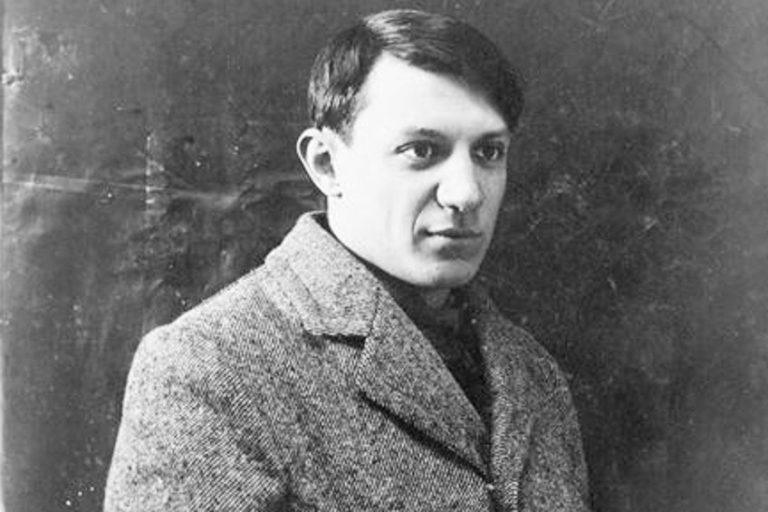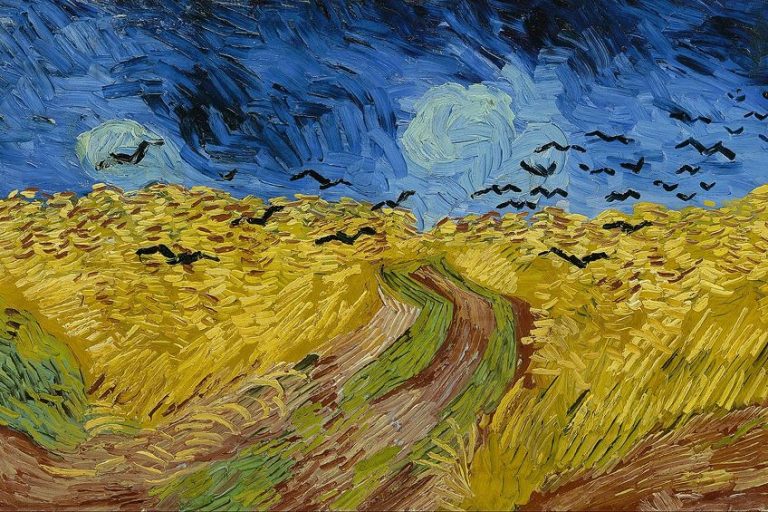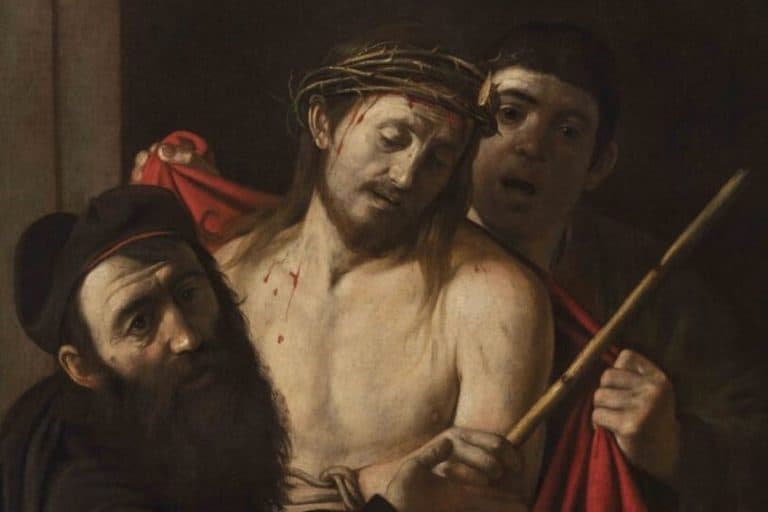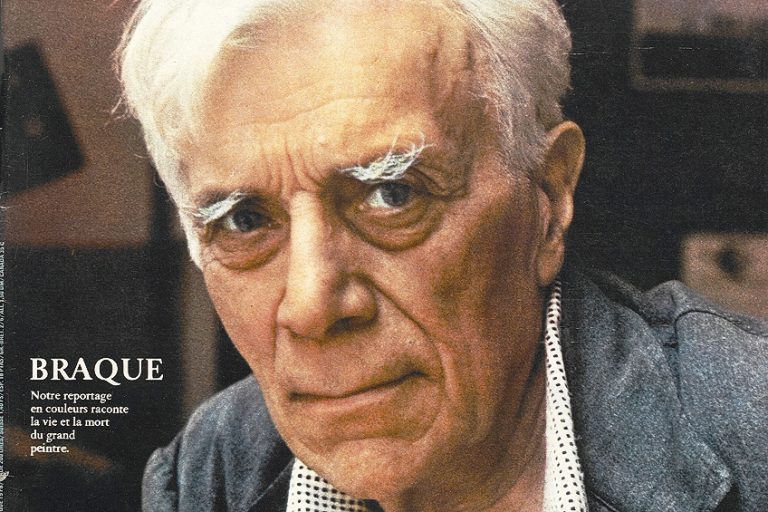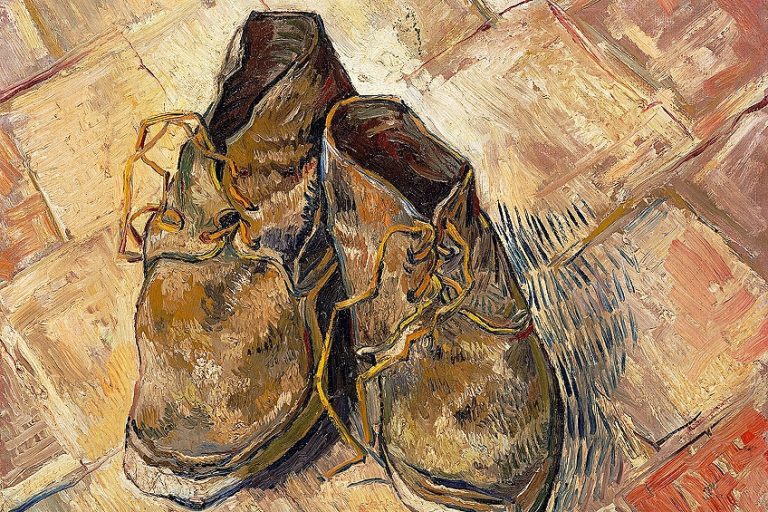“Tiger in a Tropical Storm” by Henri Rousseau – An Analysis
Tiger in a Tropical Storm by Henri Rousseau is among the best-known paintings of a tiger that was created in 1891. You may also be surprised to discover that Rousseau’s painting later inspired the comical 2005 animated film, Madagascar. The painting is widely identified as the first of many jungle-themed artworks that went on to define the style of the French Post-Impressionist and his legacy. In this article, we will explore the details of this enigmatic and striking painting that was admired by many established 20th-century modern artists, including the likes of Henri Matisse and Henri de Toulouse-Lautrec. Keep reading to learn all about the unique visual qualities of Tiger in a Tropical Storm!
Tiger, Tiger: Surprised! by Henri Rousseau
In 1891, French post-Impressionist painter Henri Rousseau gave the public a rare glimpse into a tropical jungle and captured a scene involving a cunning and dangerous tiger about to pounce on its prey. The painting was known as Tiger in a Tropical Storm and Surprised! and is credited as the iconic artwork that led to Rousseau’s ultimate success and exploration of the exotic and appealing jungle theme. While his work received both admiration and mixed reviews from critics, the painting remains a work of note from an era that was beginning to wrap its collective mind around the styles of Primitivism.
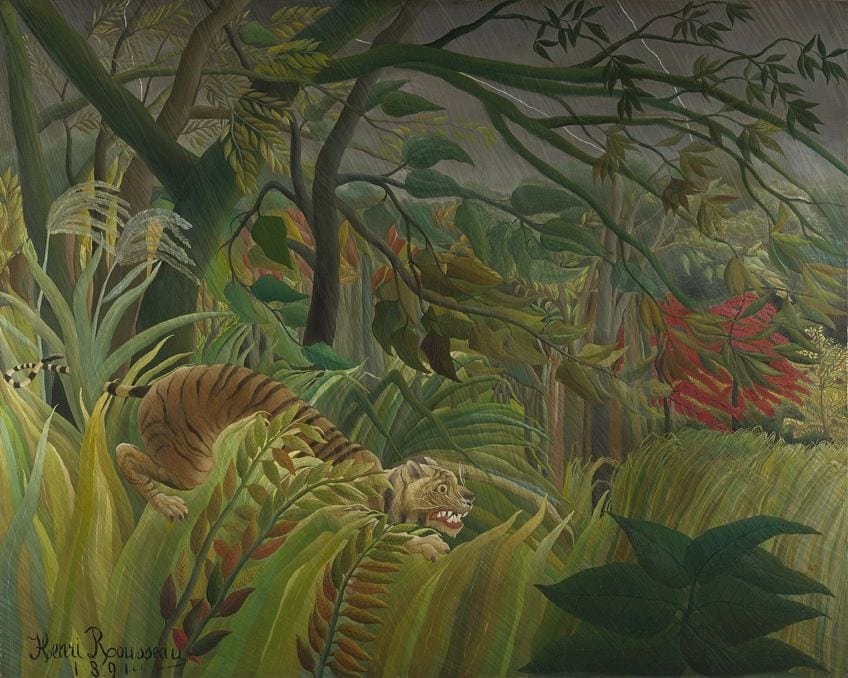
Henri Rousseau did not have a traditional start to his career and was largely self-taught. His style and technique were shaped by his experience, leading to his distinctive approach involving child-like markings, disproportionate figures, and unconventional colors, all imbued with a tinge of mystery and tension. Before he began his career as an artist at the age of 40, he worked as a tax collector and retired at the age of 49 to pursue painting full-time. Since his rise to fame and recognition in European art circles, Rousseau’s work continued to influence many generations of avant-garde artists that followed and gained the appreciation of many modern artists.
Visual Breakdown: Tiger in a Tropical Storm by Henri Rousseau
| Artist Name | Henri Julien Félix Rousseau (1844 – 1910) |
| Date | 1891 |
| Medium | Oil on canvas |
| Dimensions (cm) | 130 x 162 |
| Where It Is Housed | National Gallery, London, United Kingdom |
Tiger in a Tropical Storm was the beginning of artistic success for the middle-aged Henri Rousseau, who had bravely left behind his previous career for one that allowed him more freedom to create and explore his artistic capabilities. In 1886, he started to exhibit work frequently at the Salon des Indépendants, and attracted a significant following before the debut of his hit painting Tiger in a Tropical Storm, also known as Surprised!. The painting itself depicts a tiger in a jungle that is faced with not only the elements and impact of the tropical storm but also the need to satiate its hunger. The tiger is portrayed in the moment it appears to attack or pounce on its unseen prey. While the painting is one of 20 jungle-themed artworks in the artist’s collection, one must also note that they were birthed from a creative mind.
Henri Rousseau once claimed that his works were a product of his observations as a bandsman in Mexico, however, did not specify that his observations only extended as far as the Loire valley.
Another important point to note is the view of such animals that Europeans possessed at the time, which was aided by the help of animal painters in academic art circles who considered tigers to be “exotic” due to their affiliation with India. The scene also captures a moment when a flash of lightning illuminates the tiger’s body, which evokes a sense of ambiguity. One is left to question which subject is doing the “surprising” and whether it is the tiger that is being surprised by the lightning or the invisible prey that is about to be surprised by the tiger. Either way, the piece is an interesting and unique display of tension.
Key Themes and Context
The French painter received his first critical review after exhibiting the painting in 1891 after an artist known as Félix Vallotton described his work as “the alpha and omega of painting”. At the time, Rousseau was also largely influenced by the work of Eugene Delacroix and his painting in 1862 entitled Tiger and Snake. One will also spot popular 19th-century plants such as the Mother-in-law’s tongue and a rubber plant in the foreground of the painting.
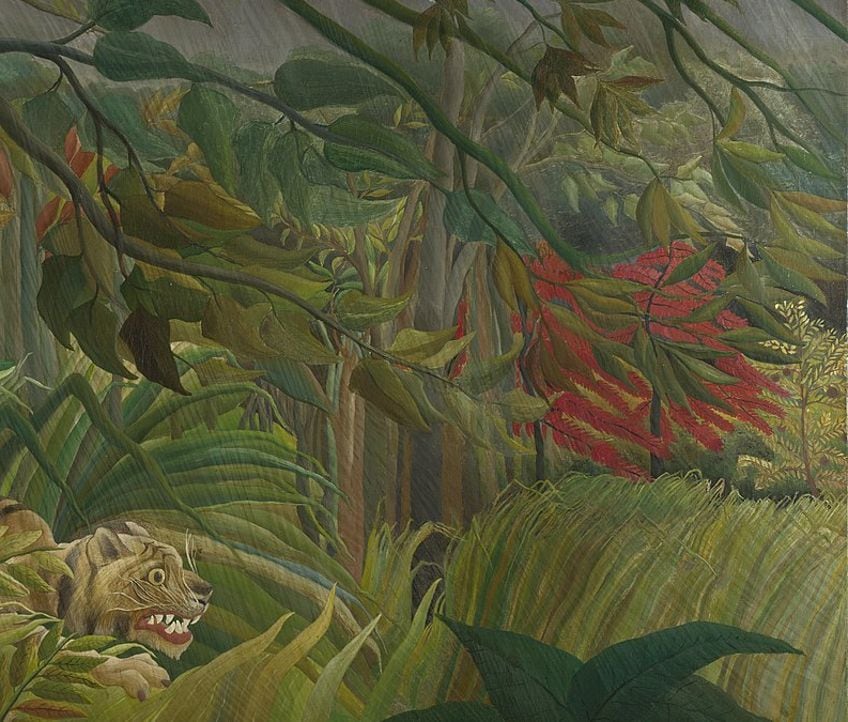
What makes the painting stand out is the fact that it was centered around the theme of the jungle, however, the vegetation depicted in the painting was not rendered in a naturalistic state, nor were they an accurate depiction of vegetation that would normally be found in a jungle environment. The theme of the tiger was soon to appear in at least three other artworks by Rousseau, as well as later in his career. The invisible prey of the tiger also leads one to believe that the prey is located beyond the edge of the canvas, such that the viewer is only left with their imagination to fill in the gap of what the outcome of the scene is. At a later stage, Rousseau himself also confirmed that the tiger in the painting was intended to attack a group of explorers.
So, what inspired the French artist to select the theme of the jungle? According to reports, it was rumored that Rousseau experienced living in a jungle in 1860 during a period in Mexico, where he worked as a regimental bandsman. However, this was disproved since it is believed that the artist never left France and was perhaps inspired by the gardens of Paris and the Paris Zoo.
Coupled with Rousseau’s vivid imagination, this famous tiger painting was born from the many exotic images and tropical landscapes that the artist felt inclined to depict.
As previously mentioned, the art world in French circles was particularly fascinated by foreign images and themes of danger and exoticism, which Rousseau contributed to. It was a way for people to travel without leaving Europe and witness, even if it were fictional, glimpses into different societal structures, environments, and animals from parts of the world that were foreign to Europeans. In 1889, the World Fair encouraged Parisians to catch a glimpse of what “native life” was for those colonized by the French, which promoted the appeal leading up to Rousseau’s painting.
Formal Elements and Style
Rousseau’s unique painting style mimicked the visual languages associated with Primitive and Naïve art, which was also unclear as to whether he intended to paint as such or had simply developed this style much earlier in childhood. His style was defined by exaggerated forms and simplified figures that were rendered in flat blocks of bold color. Rousseau’s execution was similar to the styles found in folk art and was categorized as primarily Naïve in the eyes of the 19th-century art world.

The composition of Tiger in a Tropical Storm is dominated by the greenery and warm hues of the jungle, such that the tiger blends in with the vegetation. The point at which the viewer recognizes the tiger is through its curved hind legs and spine, which adds a balance of form to the rest of the image which contains mostly delicate curves and lines. The sense of terror is illuminated by the tiger’s face and bright white teeth, which the unseen lightning seems to cast a highlight on.
The form of the tiger also appears to defy gravity as it bares its teeth and exposes its red gums while strangely positioning itself on a frond. Depth is also given to the scene through the values of the vegetation, with some leaves and plants painted in darker shades than others, and the areas where the flash of lightning passes over, painted in lighter shades.
In a manner of hypnosis, Rousseau also used a combination of diagonal and vertical lines across the composition to illustrate the unforgiving nature of the wild and the ability to get lost within the visual clutter.
The cropped composition also leaves no room for the viewer to attempt to avoid the scene and creates a sense of immediacy. The color palette used across the painting includes a mixture of green hues with elements of red, orange, yellow, and hues associated with tropical vegetation. The sense of movement and tension is rife in the painting and is further heightened with the presence of the storm, illustrated by the ominous atmosphere and streaks of rain scattered across the composition.
Significant Painting Techniques
It is believed that Rousseau’s paintings were created in layers of oil as he applied a variety of green hues to portray the lushness of the jungle. He also opted for traditional brushes in a post-Impressionist context, which saw the popularity of flat ferrule brushes. How did he execute the rain marks? Rousseau invented his own technique by dripping lines of silver paint in diagonal patterns across the canvas and reportedly used a pantograph when transferring his preparatory drawings to large-format paintings.

Rousseau’s Jungle: Criticism and Legacy
While many may have missed the imaginative qualities in Rousseau’s Tiger in a Tropical Storm, you cannot skip over the impact that his work had on providing a new perspective on the power of creativity for an artist who spent his free time teaching himself how to paint. The painting may not be an accurate or realistic depiction of a real jungle; however, it showcases the genius of mental collage and the imagination of Rousseau, who sought inspiration from his local environment. The plants spotted in the painting were derived from local flora and fauna, which Rousseau observed in Parisian gardens and the tiger was more than likely inspired by a real tiger in the Paris zoo or a taxidermied specimen.
While there were critics who rebuked Rousseau’s work, he did attract followers from far and wide, including the likes of Comtesse de Delaunay, who was Robert Delaunay’s mother, Henri Matisse, Pablo Picasso, Paul Signac, and Constantin Brâncuși, among many others.
Henri Rousseau’s paintings were also exhibited at the first Der Blaue Reiter show, which went on to move and influence many creatives, including poets such as Sylvia Plath and Wallace Stevens. Many Surrealists of the 20th century were also inspired by Rousseau’s work who admired his eccentric approach and use of large scales to depict scenes conjured by his imagination in such a dream-like manner. Even Picasso wished to see his work recognized by giving his collection of Rousseau’s work to the Louvre Museum. Tiger in a Tropical Storm was originally bought by the art dealer Ambroise Vollard in 1908 for around 190 francs. In 1972, Tiger in a Tropical Storm was purchased by the National Gallery in London with the aid of Walter H. Annenberg.

Between 1984 and 1985, Rousseau’s works were exhibited across two major museums, including the Museum of Modern Art and the Grand Palais. In 2005, his work was also shown at Tate Modern in a major show entitled Henri Rousseau: Jungles in Paris, which ran for four months and appeared at the Musee de Orsay. In 2006, a collection of 49 paintings was exhibited at the National Gallery of Art in Washington, followed by a larger show at Grand Palais in 2006. One might also recognize the colors and palette of Rousseau’s work in the 2005 animation Madagascar, which was inspired by the artist’s work, as well as most recently in Facebook’s rebrand campaign for the introduction of Meta. Today, one can easily purchase a color-verified replica of the painting sold as a print and authorized by the National Gallery at King and McGaw.
Tiger in a Tropical Storm by Henri Rousseau is a fascinating painting that represents more than just a 19th-century preoccupation with landscapes and elements of foreign lands. The painting also reflects the imaginative abilities of Henri Rousseau, who developed a distinct style using his own approaches despite the criticism from art critics. We hope that the creativity of Henri Rousseau will also inspire you to chase after your artistic passions, regardless of whether you have formal academic training or not.
Frequently Asked Questions
Who Created Tiger in a Tropical Storm?
19th-century French painter Henri Rousseau created the famous tiger painting titled Tiger in a Tropical Storm, also identified as Surprised! in 1891. Rousseau began his art career in his forties and taught himself how to paint.
What Style Is Tiger in a Tropical Storm Painted In?
Tiger in a Tropical Storm (1891) by Henri Rousseau is painted in a modern art style described by the influences of Primitivism, Naïve art, and Post-Impressionism, which Rousseau was identified with.
What Is the Meaning Behind Tiger in a Tropical Storm?
The significance and meaning behind Henri Rousseau’s painting, Tiger in a Tropical Storm (1891), revolves around the ambiguity of fear and tension expressed through the relationships between the tiger, which is a typical animal associated with wildlife and danger, alongside the power of the tropical storm. This is demonstrated by the force of the wind seen in the vegetation and the awkward stance of the tiger, whose grace has been removed by the flash of lightning.
Jordan Anthony is a film photographer, curator, and arts writer based in Cape Town, South Africa. Anthony schooled in Durban and graduated from the University of the Witwatersrand, Johannesburg, with a Bachelor of Art in Fine Arts. During her studies, she explored additional electives in archaeology and psychology, while focusing on themes such as healing, identity, dreams, and intuitive creation in her Contemporary art practice. She has since worked and collaborated with various professionals in the local art industry, including the KZNSA Gallery in Durban (with Strauss & Co.), Turbine Art Fair (via overheard in the gallery), and the Wits Art Museum.
Anthony’s interests include subjects and themes related to philosophy, memory, and esotericism. Her personal photography archive traces her exploration of film through abstract manipulations of color, portraiture, candid photography, and urban landscapes. Her favorite art movements include Surrealism and Fluxus, as well as art produced by ancient civilizations. Anthony’s earliest encounters with art began in childhood with a book on Salvador Dalí and imagery from old recipe books, medical books, and religious literature. She also enjoys the allure of found objects, brown noise, and constellations.
Learn more about Jordan Anthony and the Art in Context Team.
Cite this Article
Jordan, Anthony, ““Tiger in a Tropical Storm” by Henri Rousseau – An Analysis.” Art in Context. February 6, 2024. URL: https://artincontext.org/tiger-in-a-tropical-storm-by-henri-rousseau/
Anthony, J. (2024, 6 February). “Tiger in a Tropical Storm” by Henri Rousseau – An Analysis. Art in Context. https://artincontext.org/tiger-in-a-tropical-storm-by-henri-rousseau/
Anthony, Jordan. ““Tiger in a Tropical Storm” by Henri Rousseau – An Analysis.” Art in Context, February 6, 2024. https://artincontext.org/tiger-in-a-tropical-storm-by-henri-rousseau/.




